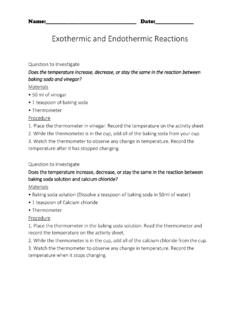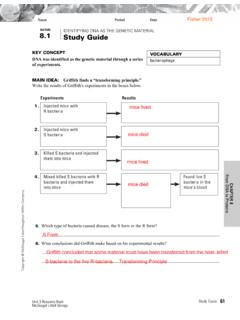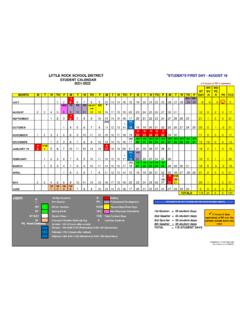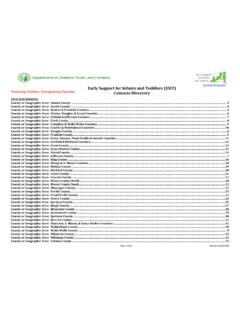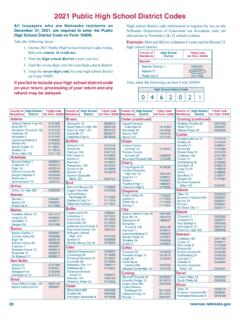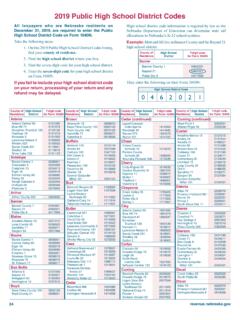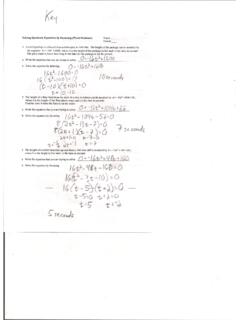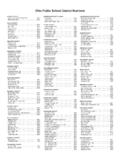Transcription of Coulomb’s Law Problems - Council Rock School District
1 PHLYZICS Coulomb s Law Worksheet Solutions 1. Two charged spheres 10 cm apart attract each other with a force of x 10 6 N. What force results from each of the following changes, considered separately? a) Both charges are doubled and the distance remains the same. b) An uncharged, identical sphere is touched to one of the spheres, and then taken far away. c) The separation is increased to 30 cm. )63(9191)3( )63( )63(44224222121212121212121 2. The force of electrostatic repulsion between two small positively charged objects, A and B, is x 10 5 N when AB = What is the force of repulsion if AB is increased to a) m b) m NENENENE64) (91 its1/9th toforce thereduce distance, theTriple b)69) (41force. equarter th distance, theDouble a),d1F Since2 3. Calculate the force between charges of x 10 8 C and x 10 7 C if they are cm apart. (.
2 05m)7C)-8C)(1E-)(5E( 2mN22122 4. What is the magnitude of the force a x 10 6 C charge exerts on a x 10 4 C charge located m away? ( )4C)-6C)( )( ( 2mN22122 5. Two spheres; cm apart, attract each other with a force of x 10 9 N. Determine the magnitude of the charge on each, if one has twice the charge (of the opposite sign) as the other. (.04m))(q)(2q)( (d))(q)(2q)(dkqF 2mN222122 6. Two equal charges of magnitude x 10 7 C experience an electrostatic force of x 10 4 N. How far apart are the centers of the two charges? )-7C)( )( ( )(q)(2q)(dkqF 22mN221 7. How many electrons must be removed from a neutral, isolated conducting sphere to give it a positive charge of x 10 8 C? 8. What will be the force of electric repulsion between two small spheres placed m apart, if each has a deficit of 108 electrons? (1m)11C)-11C)( )( ( ) ()81(ne 2mN22122 9.
3 Two identical, small spheres of mass g are fastened to the ends of a long light, flexible, insulating fishline. The fishline is suspended by a hook in the ceiling at its exact centre. The spheres are each given an identical electric charge. They are in static equilibrium, with an angle of 30 between the string halves, as shown. Calculate the magnitude of the charge on each sphere. (Hint: start off by drawing a FULL, DETAILED FBD of one of the charged spheres). (.15529m))q( )15(.30m)(sin2 distance )0196(.15tan/15tan0196.).8(.002kg)(9mgT2 2mN22221eoxesmy222mg Fe Ty Tx T 15o .3m 15o (.3)sin(15o) .30 m 10. Three negatively charged spheres, each with a charge of x 10 6 C, are fixed at the vertices of an equilateral triangle whose sides are 20 cm long. Calculate the magnitude and direction of the net electric force on each sphere. (.2m)6C)-6C)(4E-)(4E( .2m .2m .2m 4C 4C 4C 60o 60o = 30o N 4C 4C 4C 60o 150o 150o 150o Instead of giving three different directions, we can give one direction that applies to all 3 forces.
4 Outward, 150 away from each side 11. Three objects, carrying charges of x 10 6 C, x 10 6 C, and + x 10 6 C, respectively, are placed in a line, equally spaced from left to right by a distance of m. Calculate the magnitude and direction of the net force acting on each charge that results from the presence of the other two. ][ ][32364.][ ][32364.,32364.(1m)6C)-6C)(9E-)(-4E( ][ , (.5m)6C)-9E6C)(-)(-9E( ][ ][ ][86304.][ , (.5m)6C)-6C)(9E-)(-6E( ][86304.,86304.(.5m)6C)-6C)(-6E-)(-4E( ][5394.][32364.][86304.][32364.,32364.(1 m)6C)-6C)(9E-)(-4E( ][86304.,86304.(.5m)6C)-6C)(-6E-)(-4E( -4C -6C +9C .5m .5m 12. Delicate measurements indicate that the Earth has an electric field surrounding it, similar to that around a positively charged sphere. Its magnitude at the surface of the Earth is about 100 N/C. What charge would an oil drop of mass x 10 15 kg have to have, in order to remain suspended by the Earth s electric field?
5 Give your answer in coulombs ? ) )(152(100qCN100mgCN100qmg weight. thebalanceperfectly must Force Electric theearth, theabove suspendedremain ToCN100qFE2 13. Compute the gravitational force and the electric force between the electron and the proton in the hydrogen atom if they are x 10-11 meters apart. Then calculate the ratio of Fe to Fg. )-( ) )(-)( ( )-( ) )(-)( ( 14. The earth is used to ground objects. That is because its neutral. If the earth is neutral, then we will be neutral as well (since we are touching it). Neutral doesn t attract neutral. 17. Two point charges of + and + are fixed at opposite ends of a meter stick. Where on the meter stick (if anywhere!) could (a) a free electron and (b) a free proton be placed so that they are in electrostatic equilibrium (and won t move). placed is charge C2 the wherecm, proton or electron )-(4E)1(6)-(2EQ)1(Q)1(QxQ)1(QxQdkQdkQFF2 12122212221e2e1cmmxxxxxxxqq 18.
6 Using the same orbital distance from problem #13 above, find the orbital speed and the centripetal acceleration (in g s) of an electron orbiting the nucleus of a hydrogen atom (assuming the orbit to be circular). sgEERvaEvmEvkgENERmvFFsmcsmcce' ) () (





